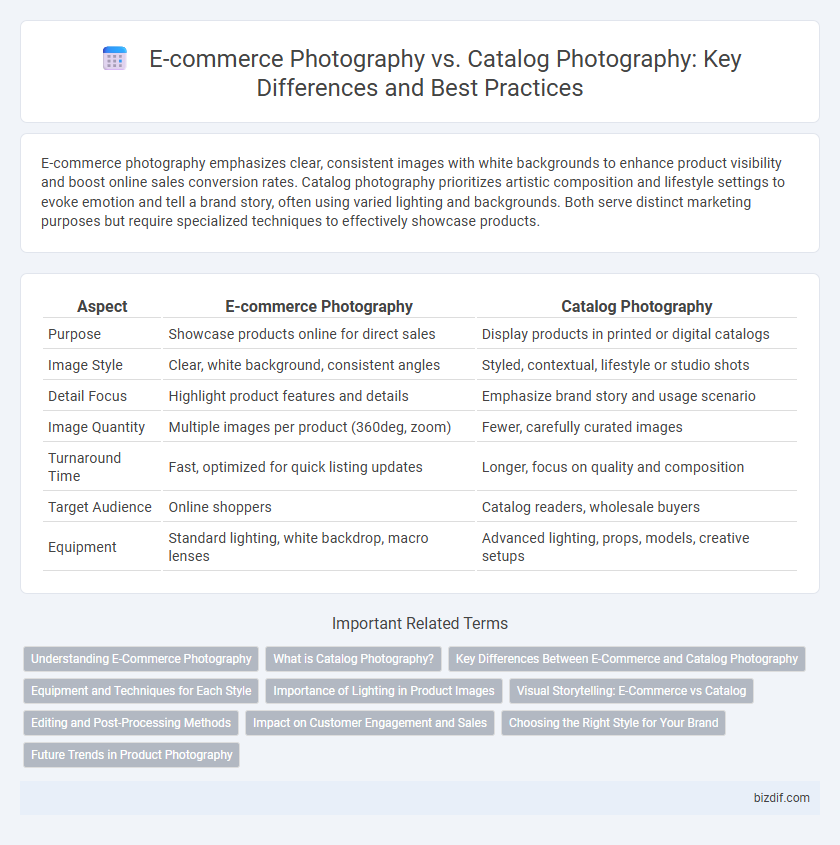E-commerce photography emphasizes clear, consistent images with white backgrounds to enhance product visibility and boost online sales conversion rates. Catalog photography prioritizes artistic composition and lifestyle settings to evoke emotion and tell a brand story, often using varied lighting and backgrounds. Both serve distinct marketing purposes but require specialized techniques to effectively showcase products.
Table of Comparison
| Aspect | E-commerce Photography | Catalog Photography |
|---|---|---|
| Purpose | Showcase products online for direct sales | Display products in printed or digital catalogs |
| Image Style | Clear, white background, consistent angles | Styled, contextual, lifestyle or studio shots |
| Detail Focus | Highlight product features and details | Emphasize brand story and usage scenario |
| Image Quantity | Multiple images per product (360deg, zoom) | Fewer, carefully curated images |
| Turnaround Time | Fast, optimized for quick listing updates | Longer, focus on quality and composition |
| Target Audience | Online shoppers | Catalog readers, wholesale buyers |
| Equipment | Standard lighting, white backdrop, macro lenses | Advanced lighting, props, models, creative setups |
Understanding E-Commerce Photography
E-commerce photography prioritizes clear, high-resolution images that showcase products from multiple angles to enhance online shopping experiences and increase conversion rates. Unlike catalog photography, which often emphasizes artistic composition and storytelling, e-commerce photography focuses on consistency, accurate color representation, and simple backgrounds to ensure products are easily identifiable. Optimizing images for fast loading times and mobile devices is crucial in e-commerce photography to improve site performance and user engagement.
What is Catalog Photography?
Catalog photography involves capturing high-quality images of products in a consistent style, optimized for print or digital catalogs to showcase a wide range of items clearly and attractively. This type of photography prioritizes uniform backgrounds, straightforward angles, and precise lighting to emphasize product details and ensure visual consistency across an entire catalog. Catalog photography supports brands in presenting their inventory systematically, enhancing customer experience by providing clear and reliable product representations.
Key Differences Between E-Commerce and Catalog Photography
E-commerce photography centers on capturing clear, high-resolution images of individual products with uniform backgrounds to facilitate quick online purchases, emphasizing product visibility and consistency. Catalog photography often involves more stylized setups, incorporating models, props, and varied backgrounds to create emotional appeal and lifestyle context that drives customer engagement. The key difference lies in e-commerce prioritizing speed, clarity, and multiple angles for user convenience, while catalog photography focuses on storytelling and aesthetic presentation to enhance brand identity.
Equipment and Techniques for Each Style
E-commerce photography relies on high-resolution cameras, consistent lighting setups with softboxes, and plain backgrounds to emphasize product details and ensure fast image processing. Catalog photography often utilizes advanced lighting techniques like three-point lighting, intricate props, and creative backdrops to create lifestyle contexts that engage viewers emotionally. While e-commerce prioritizes efficiency and uniformity, catalog photography demands artistic composition and specialized lenses to highlight textures and appeal.
Importance of Lighting in Product Images
Lighting in e-commerce photography is crucial for accurately representing product colors and textures, enhancing visual appeal to drive online sales. In catalog photography, controlled lighting setups emphasize consistency and detail, ensuring products look uniform across printed media. Both styles rely on strategic lighting to highlight key features and create a compelling visual narrative that influences consumer purchasing decisions.
Visual Storytelling: E-Commerce vs Catalog
E-commerce photography emphasizes dynamic visual storytelling by showcasing products in use, creating engaging and relatable content that drives online sales. Catalog photography focuses on consistent, high-quality images with clear, detailed views to provide customers with accurate product information for decision-making. Both styles integrate lighting, composition, and context but serve distinct purposes in enhancing the customer's shopping experience and brand perception.
Editing and Post-Processing Methods
E-commerce photography prioritizes rapid editing workflows with consistent color correction and background removal to enhance product visibility and ensure uniformity across online platforms. Catalog photography involves meticulous retouching, including shadow adjustments, texture refinement, and detailed color grading to achieve a polished, high-quality look that supports traditional print standards. Advanced software tools like Adobe Photoshop and Lightroom are essential in both methods, but catalog photography typically demands more time-intensive, intricate post-processing techniques to meet brand presentation requirements.
Impact on Customer Engagement and Sales
E-commerce photography emphasizes high-quality, detailed images with multiple angles and zoom features to enhance online customer engagement and boost sales by providing a clear product view, increasing buyer confidence. Catalog photography prioritizes stylistic, professionally composed images that showcase products in curated settings, appealing to a target audience through visual storytelling and brand identity, which can drive catalog-based sales. Both styles impact purchasing decisions, but e-commerce photography directly influences conversion rates through interactive presentation, while catalog photography strengthens brand loyalty and aspirational appeal.
Choosing the Right Style for Your Brand
E-commerce photography emphasizes clean, high-resolution images with white backgrounds to enhance online product visibility and drive sales conversion. Catalog photography often features styled environments and contextual props, creating an emotional connection and showcasing product usage for print or digital catalogs. Selecting the right style depends on your brand identity, target audience, and platform, ensuring consistency and maximizing appeal across marketing channels.
Future Trends in Product Photography
E-commerce photography is rapidly evolving with advancements in AI-driven image optimization and interactive 360-degree views, enhancing online customer engagement and boosting conversion rates. Catalog photography continues to emphasize high-resolution, meticulously styled images for print and digital mediums, but is increasingly integrating augmented reality to offer immersive shopping experiences. Future trends indicate a convergence of both types towards hyper-realistic visuals powered by machine learning, enabling personalized and seamless product visualization across multiple platforms.
E-commerce Photography vs Catalog Photography Infographic

 bizdif.com
bizdif.com